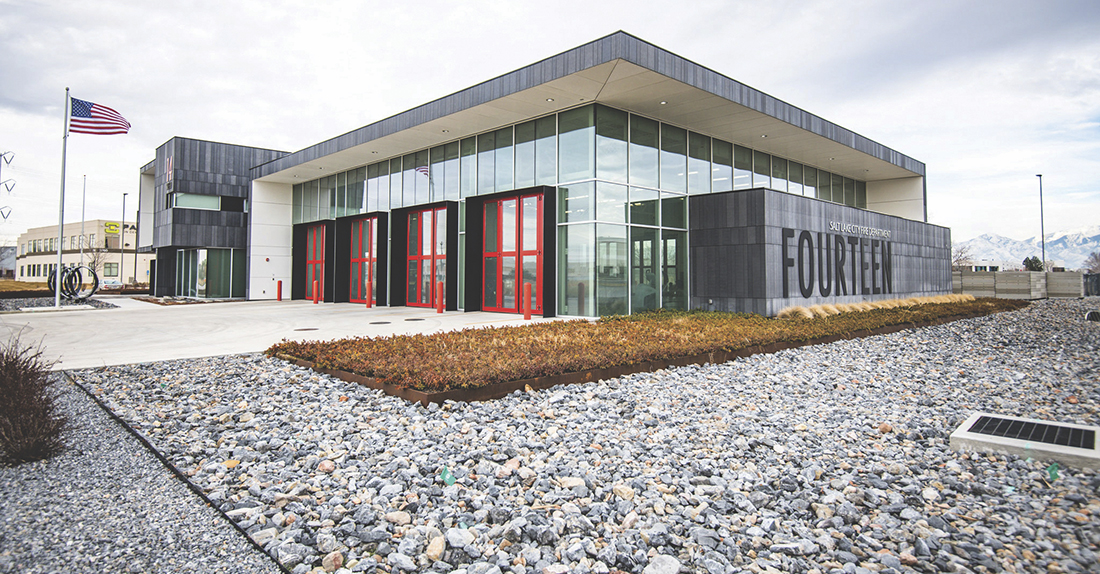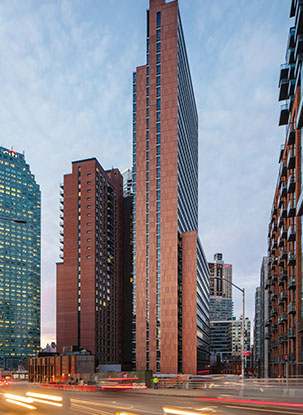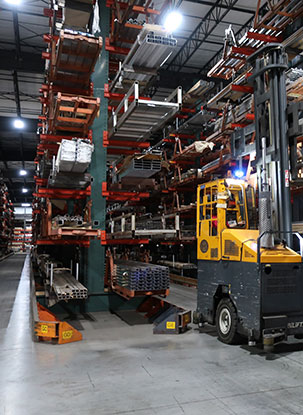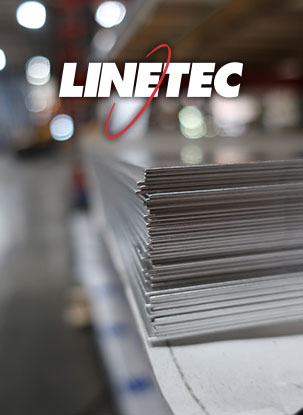
Transportation facilities, transit oriented developments and other high-traffic city centers provide the connecting points and places that compose our urban landscapes and skylines. They also can present significant challenges in protecting exterior-facing architectural aluminum products. Without proper precautions and finishes, corrosion to finished aluminum components ultimately can damage the structural integrity of the building envelope and can lead to systemic failure.
Windows, storefronts, entrances and curtainwalls, sun shades, canopies, skylights, column covers, rain screens and exterior panels all commonly are manufactured from aluminum and integrally connect to a building’s façade. In almost any city, these architectural aluminum products are continually exposed to not only weathering, but to pollution and chemicals, as well as bumps and scuffs of pedestrians. While salt spray performance considerations usually are reserved for coastal conditions, it’s important to remember that salt mixture often is used to de-ice roads making it an equal concern in colder climates.
As a prominent part of the building’s exterior, the finished aluminum adds color and design to the project; this coating also protects the building from unsympathetic surroundings. The American Architectural Manufacturers Association (AAMA) continues to set the highest standard for architectural finishes, especially in highly corrosive environments. When selecting a coating that will be required to withstand such conditions, select either the highest-performing organic paint coating that meets the AAMA 2605 specification, or a Class I anodize that meets AAMA 611.
 High-Performance Painted Coatings
High-Performance Painted Coatings
High-performance, 70 percent polyvinylidene fluoride (PVDF) resin-based coatings give architects, specifiers and building owners the capability to select nearly any conceivable color or combination of colors, while shielding the building against weathering, pollution and aging.
PVDF is known for its exceptional chemical stability and excellent resistance to ultraviolet (UV) radiation. It is used in architectural applications as a coating on aluminum where it provides exceptional resistance to environmental exposure.

The carbon-fluorine bond, used in the 70 percent PVDF, including Kynar® 500 resin-based architectural coatings, is one of the strongest bonds known. These paint coatings can withstand enduring and intense UV radiation. Such attributes support long-term color- and gloss-retention, and chalk-resistance.
These highest-performing 70 percent PVDF coatings meet the most stringent, exterior, architectural specification AAMA 2605, “Voluntary Specification for High Performance Organic Coatings on Architectural Extrusions and Panels.” This specification requires paint coatings to meet rigorous testing performance standards including more than 4,000 hours of salt spray, and heat- and humidity-resistance.
 Corrosion-Resistant Requirements
Corrosion-Resistant Requirements
Section 8.8 of AAMA 2605 refers to the corrosion resistance requirements of all coatings that must pass these stringent guidelines:
- Humidity –The sample is exposed in a controlled heat and humidity cabinet for more than 4,000 hours at 100 degrees Fahrenheit and 100 percent relative humidity. No formation of blisters to extent greater than “few” blisters, as defined by ASTM D714.
- Cyclic corrosion testing (previous referred to as salt spray resistance) – Score the film sufficiently deep to expose the base metal. Expose the sample for 2,000 hours according to ASTM G85, Annex A5, dilute electrolyte cyclic fog/dry test. The sample must score a minimum rating of 7 on scribe or cut edges and a minimum blister rating of 8 within the test specimen field, as defined in ASTM1654.
- South Florida exposure – The coating shall maintain its film integrity, color retention, chalk resistance, gloss retention and erosion resistance properties for a minimum of 10 years on the south Florida on-fence testing site.
- Color retention – Maximum of 5ΔE Units (Hunter) of color change after the minimum 10-year exposure test. A ΔE unit is the variance or color difference measured on a vector scale from a specific point in the color space.
 Chalk resistance – Chalking shall be no more than that represented by a No. 8 rating for colors and No. 6 for whites after 10 years of test fence exposure. Per ASTM D4214, chalking is measured on a numerical scale with higher numbers representing better chalk resistance.
Chalk resistance – Chalking shall be no more than that represented by a No. 8 rating for colors and No. 6 for whites after 10 years of test fence exposure. Per ASTM D4214, chalking is measured on a numerical scale with higher numbers representing better chalk resistance.- Gloss retention – Gloss retention shall be a minimum of 50 percent after the 10-year exposure testing, as described by ASTM D 523.
- Resistance to erosion – Less than 10 percent film loss after the 10-year exposure testing
- AAMA notes that high humidity environments such as, but not limited to, seacoast or industrial environments, performance of corrosion resistance may be diminished.

High-Performance Anodize Finishes
Class I anodize finishes that meet or exceed all requirements of AAMA 611 “Voluntary Specification for Anodized Architectural Aluminum” also resist the ravages of time, temperature, corrosion, humidity and warping. Anodized aluminum withstands extreme temperature changes and weather conditions, constant exposure to vehicle exhaust, and daily use by passengers. Over-sprayed salt de-icing can be managed with a simple rinsing as needed. With basic cleaning and maintenance, architectural aluminum products enjoy a long life cycle.
 The anodizing process, because it is an integral part of the substrate, produces an oxide film that is uniform, hard and protects the rest of the aluminum substrate from deterioration – providing excellent wear and abrasion resistance. The coating produced is extremely durable, and the hardness of the surface is comparable to a sapphire—the second hardest substance on earth. This characteristic makes anodize an ideal choice for use in high-traffic areas where resistance properties are important.
The anodizing process, because it is an integral part of the substrate, produces an oxide film that is uniform, hard and protects the rest of the aluminum substrate from deterioration – providing excellent wear and abrasion resistance. The coating produced is extremely durable, and the hardness of the surface is comparable to a sapphire—the second hardest substance on earth. This characteristic makes anodize an ideal choice for use in high-traffic areas where resistance properties are important.

In the most challenging applications, anodize aluminum will perform as specified and will not reduce the service life of the aluminum, but may affect the natural beauty of the surface finish. Avoid any conditions that quickly can corrode an anodize finish such as mortar, cement and other alkaline materials.
To meet AAMA 611 requirements, Class I anodize must have a dry film minimum thickness of 0.7 mils to pass these stringent guidelines:
- Abrasion Resistance (Michael Clarke Test) – A go/no-go abrasion test using abrasive papers coated with silicon carbide, garnet and glass, respectively. This is used to discriminate between films of the correct hardness and those that may give poor service because they are too soft. The specification grade of abrasive paper is Abrasive Type: Glass, Grade: “Flour,” Mohs’ Hardness Scale Number: 4.5-5.5.
- Corrosion Resistance testing (previous referred to as salt spray resistance) –Expose the sample for 3,000 hours according to ASTM B117 using 5 percent salt solution. Test samples shall show no more than a total of 15 isolated spots or pits none larger than 1 mm in diameter, in a total of 381 cm of test area grouped from five or more test pieces.
- South Florida exposure – The coating shall maintain its color retention, gloss retention and erosion resistance properties for a minimum of 10 years on the south Florida on-fence testing site.
- Color retention – Maximum of 5ΔE Units (Hunter) of color change after the minimum 10-year exposure test.
- Gloss retention – Gloss uniformity shall be within established gloss range.
Durability and Sustainability
 Anodized aluminum is an inert, non-combustible material that is 100 percent recyclable and poses no health risks. At the beginning of the new millennium, Linetec and other environmentally responsible finishers, changed from the traditional caustic etching process to a more eco-friendly etch system allowing customers to use secondary (recycled) billet in the anodize process.
Anodized aluminum is an inert, non-combustible material that is 100 percent recyclable and poses no health risks. At the beginning of the new millennium, Linetec and other environmentally responsible finishers, changed from the traditional caustic etching process to a more eco-friendly etch system allowing customers to use secondary (recycled) billet in the anodize process.
Small surface defects, such as those common in recycled material, are hidden by the eco-friendly anodize finish’s “frosty” matte appearance. Architects prefer the aesthetic of this matte finish. The resulting surface also reduces glare in bright sunlight. Gloss level reading is typically reduced from 15 to 25 with conventional anodize, down to a gloss level of 3 to 12 for eco-friendly color anodize.
The eco-friendly anodize process reduces landfill waste used with conventional etch processes by 75-80 percent. Landfill waste directly relates to the production of greenhouse gas. It also has the viscosity of water and will not collect in the small recesses of aluminum extrusions or narrow aluminum tubes, which enhances the durability and lifecycle of the finished architectural aluminum product.
 For painted architectural aluminum products, Linetec and the leading paint manufacturers recommend the use of a PVDF-based paint system on aluminum material for all corrosive environments. Offering the longest lifecycle, a 70 percent PVDF resin-based coating system, pretreated with chrome phosphate, along with an inhibitive chrome-rich primer should be used. This coating type meets or exceeds all the requirements of AAMA 2605.
For painted architectural aluminum products, Linetec and the leading paint manufacturers recommend the use of a PVDF-based paint system on aluminum material for all corrosive environments. Offering the longest lifecycle, a 70 percent PVDF resin-based coating system, pretreated with chrome phosphate, along with an inhibitive chrome-rich primer should be used. This coating type meets or exceeds all the requirements of AAMA 2605.
Beyond ensuring the highest quality application, Linetec also is recognized as an industry-leading environmentally responsible finisher. It also captures the liquid paints’ volatile organic compounds (VOCs) content using a 100 percent air capture system and safely destroys the VOCs with a regenerative thermal oxidizer. Linetec then re-uses its heat energy byproduct to improve process energy efficiency. This process of re-use is completed before the material exits the paint line.
 Specification and Selection
Specification and Selection
To ensure the finish specified on your project’s architectural aluminum products contribute to its long life, durability and sustainability, download a free PDF of “Section 05 0513 Shop Applied Coatings for Metal 3-part Guide Specification.”
For personalized assistance in selecting the finish for your next transportation or high-traffic project, please contact us and we’ll be happy to assist you.







 Chalk resistance – Chalking shall be no more than that represented by a No. 8 rating for colors and No. 6 for whites after 10 years of test fence exposure. Per ASTM D4214, chalking is measured on a numerical scale with higher numbers representing better chalk resistance.
Chalk resistance – Chalking shall be no more than that represented by a No. 8 rating for colors and No. 6 for whites after 10 years of test fence exposure. Per ASTM D4214, chalking is measured on a numerical scale with higher numbers representing better chalk resistance.